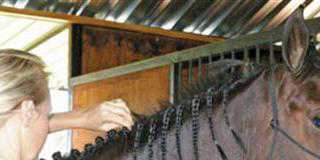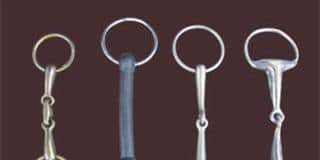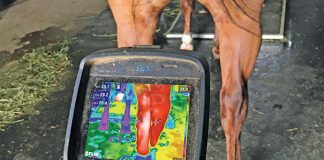The hock is one of the most complex and hardworking joints in the horse’s body. Almost everything you ask your horse to do – high-performance dressage, reining, endurance, jumping, hacking or simply riding up and down a hill – requires strong well-functioning hocks.
The hock acts as a shock absorber. If your horse has a large angle in the hock, it will be able to withstand stress and concussion better. In competitive horses, the angle should be between 154° and 159°.
A fairly flat croup, with a forward-sloping femur (the bone between the pelvic and stifle bones), a cannon set directly beneath the point of buttocks, and a sloping pastern, are also ideal.
 |
.jpg) |
 |
| Notice the swelling over the hock. |
After cold hosing the swelling has subsided. |
In this instance, the swelling has dropped down the leg. |
Hock structure
The hock comprises four separate joints within a larger structure. The top joint is a high-motion/low-concussion joint, and the three lower joints are low-motion/high-concussion joints.
A horse with poor conformation – an upright pastern and narrow-angled hock, for example – places excessive pressure on the hock. The body responds by causing the tissues to swell. If the painful inflammation is not relieved – by rest, medication or correction of the anatomy – the tissues begin to break down and the body seeks to limit the motion of the joints. The result is bony build-up and eventual natural fusion of those joints.
The two most common hock disorders are distal tarsal osteoarthritis (bone spavin) and tarsocrural effusion (bog spavin).
Some of the bone may be destroyed, leading to erosion of cartilage surfaces. Subchondral bone attached directly to the cartilage becomes brittle. Instead of being spongy, the bone is compressed, weak and painful. If damaged further, it may break.
Avoiding hock stress
There are three key steps to prevent the problem:
- Select a horse with correct conformation and strong, healthy hocks;
- Make sure the animal’s feet are balanced and properly cared for so that there is no extra stress on the hock;
- Ensure that the workload stays well within the horse’s limit. Make sure the animal is fit as you prepare it for performance. If the soft tissues are not conditioned to withstand the stress of work and are so weak that they can no longer support the limb, then the bony structures, cartilage, ligaments, and tendons will all suffer.
I like to start all horses on a six-week legging-up programme, then very gradually increase the work. The time spent on slow, gradual exercise can save you months of recovery from injury.
Sound nutrition means rapid recovery
Good nutrition is also crucial. The horse needs adequate energy to perform without becoming fatigued. If it becomes exhausted and weak from overwork, an injury is far more likely to occur.
Fitness is the body’s ability to recover from damage. If the body has the correct nutrients it will repair itself faster.
Remember to give the horse enough time to rest and recover. Most horses need 24-hour rest intervals if they are fit.
If you have to work your horse hard for a show, you can minimise the effects of inflammation by helping it to cool down immediately after exercise. There are many ways to do this – cold water hosing, ice buckets, ice wraps and ice gels. (Be sure to move the ice regularly to prevent the cells from ‘burning’.)
Doing this for 15 to 30 minutes daily after you’ve worked the horse hard, will help joints recover faster, so that inflammation is no longer present the next time you ride. It’s the additional, cumulative inflammation that does the damage. When this occurs, the cells can no longer protect the joint surfaces effectively and the synovial lining is unable to produce the lubrication needed to minimise inflammation. Fluids leak from blood vessels into the space around the joint, causing swelling.
You cannot substitute medication for proper conditioning and fitness, but if there is inflammation, a quick fix is to inject the hocks with corticosteroid or hyaluronate. This is not without risk, however, due to potential side-effects.
Finally, take time to get to know how your horse’s legs feel. The better you understand them, the more readily you will notice any anomaly.













